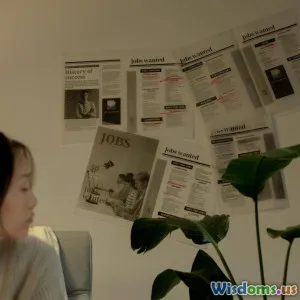
Hidden Barriers That Stop You Attracting Abundance
20 min read Explore hidden psychological and practical barriers preventing you from attracting abundance, with actionable tips to remove them for a more fulfilling life. (0 Reviews)
Hidden Barriers That Stop You Attracting Abundance
Introduction

Abundance is a deeply sought state, often associated with not just wealth but joy, health, fruitful relationships, and opportunities. Yet, many people find themselves mysteriously stuck, feeling a persistent gap between where they are and the abundant life they envision. Despite positive thinking and earnest efforts, abundance sometimes seems frustratingly out of reach. What if the real obstacles are invisible, built into our beliefs, patterns, and daily actions?
In this article, we'll dive deep into the hidden barriers that stop people from attracting abundance. We'll unravel mindsets, beliefs, habits, and environmental factors that quietly sabotage our desires—often without us ever realizing. We'll also explore practical strategies, drawing on psychology, real-world stories, and actionable steps, so you can identify and start clearing these blocks for yourself.
The Abundance Mindset vs. Scarcity Traps

The path to abundance begins in the mind. Psychologist Carol Dweck’s research on mindset shows how beliefs fundamentally shape outcomes: those with a “growth” or abundance mindset view themselves and their world as rich in opportunities. Yet, most people are steeped in a subtle “scarcity mentality” that colors every aspect of life.
Scarcity Traps:
- Always Seeing What’s Missing: Instead of gratitude and focus on what’s present, attention naturally gravitates to lack—what you don’t have, what others possess, or the constant feeling of not-enoughness.
- Zero-Sum Thinking: Believing someone else’s gain is your loss fosters competitiveness and closed-mindedness. Consider workplace environments where promotions seem limited and colleagues feel like rivals—a self-fulfilling cycle of scarcity.
- Fear-Based Decisions: Whether it’s fear of losing money, love, or time, scarcity-thinkers often avoid risks, focus on security, and unknowingly shrink their possibilities.
Case Insight: A Harvard Business Review study found that people shown images which triggered scarcity (such as empty wallets or bank accounts) performed 13% worse on problem-solving tasks than controls. Scarcity narrows focus, impeding creativity and resourcefulness, vital components of abundance.
Self-Reflection Tip: Ask yourself, “Where am I noticing lack rather than what I have?” Each time you catch yourself comparing, worrying about shortages, or assuming the worst, write it down. Awareness is the first step in dismantling scarcity thinking.
Limiting Beliefs Rooted in Childhood Conditioning

Much of our inner blockages have roots in childhood. Family attitudes about money, success, hard work, or self-worth often become deeply embedded beliefs—sometimes without a single word being spoken.
Common Limiting Beliefs:
- Money is hard to get. (“You have to work yourself sick to succeed.”)
- Successful people are greedy, lucky, or just different from you.
- You don’t deserve more than you have.
- Having more will make your family/friends uncomfortable.
- You always have to sacrifice personal joy for responsibility.
Real-World Example: Consider Sarah, who grew up in a family that viewed wealth with suspicion—"rich people must've done something bad to get there." As an adult, each time she got close to a financial breakthrough, she unconsciously self-sabotaged deals or didn't follow up on opportunities, secretly fearing she’d become ‘different’. It took her years, with therapy and journaling, to identify that her loyalty to these old beliefs was undermining her dreams.
Action Steps:
- Journaling Exercise: Write a letter from your ‘inner child’ about money, success, and self-worth. What messages did you absorb, directly or indirectly?
- Challenge the Evidence: For each negative belief, list 3 examples from people you admire who prove the opposite. Is the belief universally true, or just inherited?
Perfectionism and Fear of Failure

One subtle yet potent blocker is perfectionism—the need to get everything “just right” before taking a step. This stems from an underlying fear of making mistakes, looking foolish, or falling short. Unfortunately, abundance flows through action, experimentation, and a willingness to embrace detours. Perfectionism paralyzes and restricts this natural flow.
Key Points:
- Analysis Paralysis: According to studies by Psychology Today, perfectionists spend up to 50% more time planning and less time acting, causing missed opportunities and burnout.
- Fear of Judgment: Social media research shows lower content sharing among those who report higher perfectionistic tendencies.
- Self-Sabotage: Rather than risk imperfection, people give up early, keeping themselves “safe” from criticism—but also from growth and abundance.
Experience Share: Jake wanted to launch a side business but spent years editing his website, worrying over colors, logos, and not feeling “ready.” He finally started with a basic version after a mentor said, “Done is better than perfect.” Only then did new opportunities start to emerge.
Tips to Overcome:
- Commit to imperfect action—set micro-goals: “What is the smallest, imperfect step I can take this week?”
- Use mantras like “Progress over perfection.”
- Reflect on the cost of waiting compared to what you might learn by doing.
Subconscious Associations: Guilt and Shame

Many people harbor deep-seated shame or guilt about receiving abundance, especially if it relates to money or love. This is rarely logical or conscious. Instead, old emotions, often linked to past failures, debts, or critical remarks, create a tug-of-war inside.
Common Symptoms:
- Feeling “bad” or uncomfortable when receiving a windfall or praise.
- Lowering your rates or turning down opportunities so as not to “outshine” others.
- Subtle self-sabotage, like splurging right after earning extra, leaving you back at square one.
Psychological Insight: Research from the University of California found that guilt reflexes activate the same brain areas as physical pain. This explains why some people find actual discomfort in success or abundance—it quite literally "hurts" to surpass their internal threshold.
How to Shift:
- List Your Wins: Start a “Wins Journal” and record every value you provide and every win, no matter how small.
- Reframe Receiving: Think of abundance as a resource for positive impact—what good could you do for yourself and others if you allowed more in?
- Practice Receiving: Allow compliments and support from friends. Don't rush to deflect; practice saying, “Thank you.”
The Company You Keep: Environmental Influences

Your environment is more than physical; your social sphere—friends, family, colleagues—subtly shapes your beliefs, ambitions, and self-worth day by day. Jim Rohn famously said, “You are the average of the five people you spend the most time with.”
Consider These Scenarios:
- Dream Diminishers: Do those around you encourage growth, or do they belittle risks and downplay dreams? Mild mockery (“That’s too ambitious for us!”) often masks their own scarcity beliefs, which you may subconsciously adopt.
- Enablers of Old Patterns: Close circles might reinforce self-imposed limits. If nobody around you strives for more, apathy becomes normal.
- Anonymous Influence: Even digital spaces—social media, news, or online communities—can instill optimism or pessimism depending on their narratives.
Comparison Example: In a study by Nicholas Christakis of Harvard, happiness—and by extension abundance—tends to spread in social networks. If your friends are upbeat and successful, you are 15-34% more likely to echo those traits. The same logic applies inversely to scarcity and self-doubt.
Action:
- Audit your environment: Who genuinely supports expansive thinking?
- Choose to spend time (physically or virtually) with people who challenge and inspire you.
Procrastination and Unclear Priorities

A hidden but widespread block to abundance is chronic procrastination rooted in unclear goals and priorities. When you don’t know exactly what abundance looks like for you, it’s easy to be busy without progress, spinning your wheels on unimportant tasks or endlessly postponing meaningful action.
Why This Happens:
- Ambiguity Breeds Inaction: Without clarity, the brain feels overwhelmed and defaults to the path of least resistance—usually routine distractions instead of bold steps.
- Emotional Avoidance: Starting something new or big requires emotional investment. Instead, people retreat to time-fillers like social media, chores, or minor work tasks.
- Misaligned Goals: Seeking abundance for others’ validation, rather than personal alignment, leads to resistance and early fatigue.
Practical Steps:
- Define your version of abundance (money, health, creativity, time, love?). Paint a vivid picture.
- Break down major desires into specific, manageable actions with deadlines.
- Use time blocks: Set aside 30 minutes daily for “high-impact abundance tasks.”
Case Study: Maria wanted financial freedom. Once she clarified that, for her, it meant enough income to travel twice a year, she tailored her business choices and saved for trips, finding the energy and focus that had felt impossible before.
Negative Self-Talk and Core Identity

Self-talk is the running commentary of your mind. If it’s saturated with statements like, "I'm not good enough," "Nothing ever works for me," or "I'm just unlucky," those words shape your actions and ultimately your reality. Key research from the National Science Foundation shows that up to 80% of self-talk is negative, and more than 95% is repetitive—potentially hard-coding scarcity into your brain.
Impact of Negative Identity:
- Decisions align with your inner narrative—you unconsciously seek situations and people that reaffirm what you believe.
- Even after external success or opportunities, people revert to their 'set point' unless identity shifts occur. Lottery winners, for instance, statistically return to their previous financial baseline within five years.
Identity Shift Method:
- Change “I am” statements. Experiment with saying, “I am learning to attract abundance,” or “I am an abundant person in training.”
- Visualize yourself as a person who already embodies abundance—how would you act, dress, plan your day?
Unresolved Trauma and Emotional Blocks

Deeper wounds—trauma from losses, betrayals, or past struggles—enhance survival instincts that focus on ‘just getting by’. These emotional blocks keep us in protective mode, historically vital for survival but rarely conducive to creative expansion or generosity.
Symptoms:
- Chronic tension or anxiety over money or relationships.
- Avoidance of opportunities that are “too good to be true.”
- Repeated cycles of near-breakthroughs followed by setbacks.
Insight: Leading therapist Bessel van der Kolk posits, in "The Body Keeps the Score," that when trauma is unaddressed, the nervous system continually scans for danger, sabotaging risk-taking confidence necessary for abundance.
Ways Forward:
- Seek support: therapy, coaching, or trauma-informed workshops.
- Practice somatic exercises, meditation, or journaling to release stored emotions.
- Recognize emotional responses not as ultimate truth but as protectors—thank them, then consciously choose new actions.
Comparing and Competing Instead of Collaborating

Comparison, especially in the age of hyper-visibility, is a recipe for anxiety and stunted growth. Focused excessively on others’ successes, you may forget your unique path, start undervaluing your strengths, and potentially miss out on collaborative opportunities.
Research Highlights:
- Social psychologist Leon Festinger emphasized that chronic social comparison causes dissatisfaction. In business, those focused on competition over collaboration often experience higher burnout and lower long-term satisfaction.
Contrast in Practice:
- Competitive Mindset: “If they win, I lose.”
- Collaborative Mindset: “Their win shows what’s possible—I can learn or partner with them.”
Action Steps:
- Reach out to someone you admire, offer support, or propose a collaboration.
- Celebrate others’ successes, and notice their impact on your mental state.
- Periodically unplug from social media to reconnect with your own values and achievements.
Ignoring the Practicalities: Systems and Habits

Mindset, belief, and motivation only go so far if your daily systems work against you. The most successful people have routines and disciplines that turn intention into automatic action.
Common Systemic Barriers:
- Disorganized finances (no budget, no goal tracking)
- Chaotic workspaces, undermining focus
- Time leeches like constant email-checking or multitasking
Solution Examples:
- Use automation: Set up automatic savings or bill pay; batch similar tasks to reduce distractions.
- Audit your calendar for “busy work”—free up space for strategic thinking or learning.
- Habit-stack—for example, practice gratitude journaling alongside your morning coffee, embedding abundance-focus into routine.
James Clear’s “Atomic Habits” notes that environment shapes up to 40% of habitual behavior—aligning your systems creates compound growth and opens channels to abundance that mindset alone can’t.
Practical Steps to Remove Abundance Barriers

Integrating all insights above, here’s a comprehensive how-to plan:
- Reflect and Write: Regular journaling reveals hidden beliefs and blocks (try morning pages or gratitude lists).
- Affirm and Visualize: Set aside time daily to reaffirm your worthiness and visualize abundance—in whatever domain matters to you.
- Seek New Circles: Join groups (online or real world) where abundance language and possibility are norm.
- Audit and Optimize: Review your habits, systems, and environment monthly—declutter, organize, and automate where possible.
- Act Before Ready: Practice taking small, imperfect actions before you feel fully equipped.
- Learn and Heal: Where trauma or emotional residue exists, prioritize healing—sometimes, the block is in your nervous system, not your intellect.
- Celebrate Progress: Note even minor wins and shifts in perspective. Success, however tiny, multiplies through attention.
Conclusion

Attracting abundance is less about luck or raw talent and more about clearing invisible hurdles in your mind, habits, and daily environment. These hidden barriers—scarcity thinking, deep-seated beliefs, perfectionism, emotional blocks, and more—are entirely natural, and every person faces them at different levels. The power lies in your willingness to uncover, challenge, and shift them, day by day.
Remind yourself: Abundance isn’t a distant or mystical concept. It’s the natural state that follows clarity, courage, and aligned action. You’re not alone in this journey. Each step you take to remove your unique barriers, you not only open yourself to greater possibilities—you inspire and pave the way for others to do the same.
Start today. Even one barrier removed is a space cleared for abundance to flow in.
Rate the Post
User Reviews
Popular Posts



















